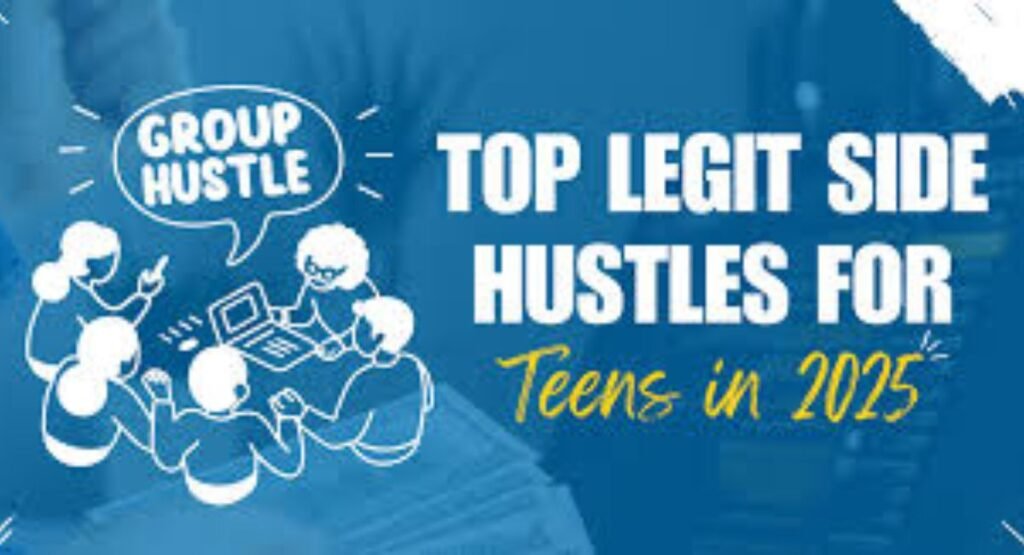The traditional part-time job is becoming rare for young people as only about 22.5% of U.S. high school students held a job in late 2023, even as teens’ entrepreneurial dreams soar.
In fact, nearly two-thirds of American teens (13–17) say they plan to start a business or side venture as adults. This gap highlights a pain point that teens want to earn and learn, but conventional jobs are scarce or rigid. Enter the side hustle. By definition, a side hustle is a flexible, often digital gig or micro-business that teens can pursue alongside school.
According to recent data, youth are the new drivers of the gig economy worldwide.
An estimated 243 million young people globally work through online gigs, from coding and design to teaching and content creation.
Online gig work now accounts for up to 12% of the world’s labor force, and young people make up over half of that share.
In the U.S., nearly half of young adults (Gen Z, ages 18–27) already have a side gig.
These trends mean that by 2025, teens with internet access, even in small towns, can tap into opportunities once out of reach.
However, challenges remain. Teens face legal work-hour limits, limited startup funds, and concerns about risk. Our problem-driven approach is to acknowledge these gaps and then show solutions like flexible side hustles that require little or no investment, build skills, and fit around school. Below, we explore the hurdles teens encounter, then spotlight a wealth of creative, tech-oriented hustles for 2025 and beyond.
Table of Contents
Why Traditional Teen Jobs Are Fading?
In recent decades, teen employment has steadily declined. BLS data show only about 1 in 4 high schoolers worked in 2023, down from over 30% in the 1990s. Many factors contribute, like tighter child labor laws, competitive markets, and even the pandemic’s lingering effects. In contrast, interest in entrepreneurship remains high.
This gap creates frustration and untapped potential. Teens need flexible income to cover expenses (college savings, gadgets, personal projects) and to learn real-world skills. Yet employers may avoid hiring minors for safety or legal reasons, and school schedules can conflict with fixed work hours. Thus, many teens feel stuck as they want to contribute or gain experience but lack outlets. Side hustles offer a solution by letting teens choose when, where, and how much to work.
The Rise of the Side Hustle Generation
The data make it clear: we are in a side-hustle era, especially among youth. By 2024, the global gig economy was valued at about $556.7 billion (hostinger.com), growing over 16% annually. Younger people are leading this trend. Nearly 48% of Gen Z adults (18–27) have a side gig, and that figure is rising.
Worldwide, millions of students and young professionals are seeking gigs for extra income, to learn, or simply because digital platforms eliminate geographical barriers. The World Bank notes that many online gig workers now live in smaller towns, not just big cities, so long as they have the internet, they can compete globally.
According to surveys, the top reasons youth join online gigs are flexible schedules and higher pay than local jobs. One chart from a global survey highlights that flexibility on time, learning digital skills, and earning more are chief motivators for teens in the gig space. In other words, teens see side hustles as a chance to be their own boss to set their hours and pursue passions while still in school.
What Perks Teens Gain from Side Hustles
- Flexible Hours: Unlike fixed teen jobs, side gigs let teens work around school and family commitments. A graphic designer or content creator can pick up work late nights or weekends, fitting tasks into free periods. This adaptability is crucial for balancing academics and personal life.
- Skill Building: Gig work often develops valuable soft and hard skills. Teens enhance time management, communication, and tech skills on the job. For example, tutoring younger kids hones teaching and communication; freelance coding improves problem-solving; running a small e-commerce venture teaches marketing and customer service. World Bank research shows young gig workers prioritize learning new digital and organizational skills.
- Financial Independence: Earning from a side hustle gives teens pocket money or savings without relying entirely on parents. It fosters budgeting and a sense of responsibility. Many teens dream of funding college or personal projects – side hustles can make that dream real.
- Career Exploration: Side gigs allow experimentation. Teens can try marketing, design, or tech roles on the side before choosing a college major. As one JA study notes, working on small projects “paves the way for future opportunities” and networking. By building a portfolio (social media posts, art pieces, code samples, etc.), teens lay the groundwork for later careers.
What Teens Must Watch Out For?
Despite the upside, side hustles come with pitfalls. It’s important to recognize them:
- Inconsistent Income: Side hustles rarely pay like a salaried job. There might be feast-or-famine cycles – busy months and slow spells. Teens must budget accordingly and not rely on it for essentials.
- Legal and Age Restrictions: Many platforms require workers to be 16 or 18+. In the U.S., labor laws limit how many hours minors can work. Teens should check age rules and involve parents when signing up for gigs. Also note: social security benefits, paid leave, and health insurance typically do not apply to gig work.
- Time Management: The risk of burnout is a real concern. FLY cautions that teens might “overcommit to gigs” at the expense of homework. Without bosses, teens must self-regulate. Clear boundaries (e.g., no work during study time) and planning are key.
- Scams and Low-Quality Gigs: The Internet Has Its Hazards. Teens must be wary of scams (jobs asking for upfront fees or personal data). Always verify opportunities, and if something sounds too good to be true (earn $500 a day with one click!), it probably is.
Teen-Friendly Side Hustles for 2025
Below are digital, low-cost side hustle ideas tailored to teenage strengths and constraints. Each can be started globally with little to no investment – usually just a smartphone or computer and an internet connection. Think of this as a menu of options. Each teen can choose what fits their skills and interests.
| Side Hustle Type | Description & Examples | Investment Needed | Key Skills/Notes |
| Content Creation & Social Media | Produce videos, graphics or posts for sharing platforms. Examples: short educational videos, comedic clips, digital art portfolios, podcasts or blogs. Content can be monetized later or used to showcase talent. | None (just a device) | Creativity, video/photo editing, storytelling. |
| Digital Product Design | Create and sell digital assets like illustrations, e-book guides, music beats, stock photos or printables. E.g., design phone wallpapers, online planners or game mods. Sold on marketplaces or through own site (optional). | Very low (software, prints are digital) | Artistic/design skills, software (free versions). |
| Online Tutoring/Education | Tutor younger students in math, languages, or coding via video chat. Design study guides or run online workshops (e.g. basic coding classes). This can be done globally using free conferencing tools. | None | Strong subject knowledge, communication, patience. |
| Freelance Services (Writing, Design, Tech) | Offer services like writing articles, graphic design, web coding, or simple app development. For example, write blog posts for small businesses, create logos, or develop mini websites/apps. Many micro-entrepreneurs seek such help. | None (use free tools) | Depends: writing, design, programming skills. |
| Virtual Assistance & Microtasks | Perform administrative or micro-tasks remotely: data entry, scheduling, language translation, or user-testing apps/websites. Teens with good attention to detail can do surveys, website reviews, or moderate forums. | None | Organization, basic computer literacy. |
| E-commerce & Reselling | Start a small online shop: e.g., use print-on-demand to sell custom t-shirts or mugs (no inventory risk), or flip gently used items by reselling them online. Some initial funds may be needed for samples or inventory, but apps now allow dropshipping with minimal cost. | Low (inventory or samples) | Entrepreneurial sense, basic marketing. |
| Gaming & Tech Gigs | Provide gaming-related services: competitive coaching, content creation (gameplay clips), or game testing/beta feedback (if platforms allow minors). Also, build simple apps or tools (even calculators or fun games) to share or sell. | Low (device/hardware) | Gaming skills, programming, critique/reporting. |
| AI-Assisted Projects | Leverage AI tools to create products or services. Teens can use generative AI (for text, art or code) to produce unique content – e.g., designing book covers, writing story prompts, or generating art pieces. This can speed up many ventures at minimal cost. | None (AI tools often freemium) | Imagination, prompts mastery, critical editing. |
Each of these hustles can be started globally as long as there’s internet. For example, a teenager in India or Nigeria can tutor English to learners in other countries, or a teen in Brazil can design graphics for clients in Europe. The World Bank notes that online gigs transcend location – so teens in small towns can access a global market. Importantly, all these ideas require little to no capital upfront (just free software or accounts). A good Wi-Fi connection and a laptop or phone are often enough.
How to Start Smart?
Identifying an idea is only the first step. Here’s how teens can overcome barriers and turn a side hustle concept into reality:
- Start Small and Build Skills. Choose one manageable gig related to a current skill or hobby. If you love drawing, begin by creating one design and offering it on social media or a marketplace. If you excel in math, tutor a neighbor or sibling to gain confidence. This small wins approach reduces risk and builds a portfolio.
- Educate Yourself. Use online resources (videos, free courses) to sharpen your skills. For instance, a budding coder might take a free programming tutorial, or a writer can study SEO basics. Also, learn financial basics: how to budget your gig earnings, save taxes, etc. FLY advises teens to “understand how to budget, save, and pay taxes” on earnings.
- Safety and Legitimacy. Always vet any opportunity. Stick to reputable platforms (those with clear reputation systems or parental oversight). Never pay to apply for a gig. Protect personal info: use an email and business account rather than your personal accounts. If a site or client feels off, trust your gut. Parents should be involved in setting up payment methods (e.g., connecting PayPal or bank accounts) to avoid fraud.
- Time Management and Boundaries. Schedule gigs like homework. If you work after school, set an alarm to stop in time for family dinner or studying. Don’t let hustle work harm grades. Many teens find that pacing—doing small tasks each day prevents burnout. Use calendars or to-do apps to track commitments.
- Networking and Support. Join teen or local entrepreneurship groups (online forums, school clubs). JA notes teens often say they need “support from parents, friends, or role models” to succeed. Mentors can offer advice or even small seed money. Share your progress with friends—they might have skills to trade (e.g., a friend who’s good at photos might help market your product).
Call to Action: Ready to dive in? Start by listing your own skills and passions.






